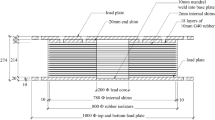Abstract
A new and innovative base isolation device is introduced in this paper based on extensive research carried out by the authors and their co-workers. A prototype of the device was built and experimentally tested on the shaking table. The new base isolation device consists of two disks, one vertical cylinder with an upper enlargement sustained by three horizontal cantilevers, and at least three inclined shape memory alloy (SMA) bars. The role of the SMA bars is to limit the relative motion between the base and the superstructure, to dissipate energy by their super-elastic constitutive law and to guarantee the re-centring of the device. To verify the expected performance, a prototype was built and tested under sinusoidal waves of displacement of increasing frequency with different amplitudes. It is shown that the main feature of the proposed base isolation device is that for cyclic loading, the super-elastic behavior of the alloy results in wide load-displacement loops, where a large amount of energy is dissipated.
Similar content being viewed by others
References
Auricchio F, Faravelli L, Magonette G and Torra V (2001), Shape Memory Alloys: Advances in Modelling and Applications, Barcelona: CIMNE.
Casciati F (2003), ed., Proceedings Third International Conference on Structural Control, Como: John Wiley & Sons.
Casciati F, Casciati S and Faravelli L (2007), “Fatigue Characterization of a Cu-based Shape Memory Alloy,” Proceedings of the Estonian Academy of Sciences — Physics Mathematics, 56(2): 207–217.
Casciati F and van Eijk C (2008), “Mechanical Properties and Microstructure Characterization of CuAlBe Shape Memory Alloys for Vibration Mitigation,” Accepted for Publication in Smart Structures & Systems.
Casciati F and Faravelli L (2004), “Experimental Characterisation of a Cu-based Shape Memory Alloy Toward Its Exploitation in Passive Control Devices,” Journal de Physique IV, 115: 299–306.
Casciati S and Faravelli L (2007), “Structural Components in Shape Memory Alloy for Localized Energy Dissipation,” Accepted for Publication in Computer & Structures.
Casciati F, Faravelli L and Hamdaoui K (2006), “Reliability Study for a New Concept of Base Isolator,” Proceedings Fifth International Conference on Computational Stochastic Mechanics, June 20–23. Rhodes, Greece, pp. 163–168.
Casciati F, Faravelli L and Hamdaoui K (2007a), “A Base Isolation Device with Bars in Shape Memory Alloys,” Proceedings First International Conference on Self Healing Materials, Amsterdam, The Netherlands.
Casciati F, Faravelli L and Hamdaoui K (2007b), “Shape Memory Alloy Bars Assembled in a Base Isolator,” Proceedings of the ANCER Conference, Hong Kong.
Casciati F, Faravelli L and Hamdaoui K (2007c), “Performance-based Design of a Shape Memory Alloy Base Isolator,” Proceedings of the 10th International Conference on Applications of Statistics and Probability in Civil Engineering, Tokyo, Japan.
Casciati F, Faravelli L and Hamdaoui K (2007d), “Numerical Modelling of a Shape Memory Alloy Base Isolator,” Proceedings of 3rd International Conference on Structural Engineering, Mechanics and Computation, Cape Town, South Africa.
Casciati F and Hamdaoui K (2007), “Modelling the Uncertainty in the Response of a Base Isolator,” Submitted for Publication in Probabilistic Engineering Mechanics.
Casciati S (2007), “Thermal Treatment Optimization for Cu-based Shape Memory Alloys,” First International Conference on Self-Healing Materials, Berlin: Springer Verlag.
Eisemberg JM, Smirnov VI and Stepanov AY (1996), “Seismoisolation and Structural Control Investigations and Applications in Russia,” Proceeding 1 st European Conference on Structural Control, Singapore: World Scientific Publishing, pp. 258–265.
Hata T and Ogura Y (2004), “Aseismic Devices Co: Development of Seismic Devices for Earthquake Protection,” Proceedings of International Symposium for Smart Structures Technologies and Earthquake Engineering (SE04), Separate Technology Volume, Osaka: Bandoh Printing & Package Ltd., Japan, pp. 5–9.
Kubo A and Suzuki J (2004), “Mitsubishi Heavy Industries: Vibration Control and Earthquake Isolation Systems,” Proceedings of International Symposium for Smart Structures Technologies and Earthquake Engineering (SE04), Separate Technology Volume, Osaka: Bandoh Printing & Package Ltd., Japan, pp. 45–47.
Nagarajaiah S (guest ed.) (2006), “Structural Control Benchmark Problem: Phase I — Linear Smart Base Isolated Building Subjected to Near Fault Earthquakes,” Structural Control & Health Monitoring, 13(2–3): 571–822.
Skinner RI, Robinson WH, McVerry GH (1993), An Introduction to Seismic Isolation, Chichester: John Wiley & Sons.
Soong TT, Dargush GF (1997), Passive Energy Dissipation Systems in Structural Engineering, Chichester: John Wiley & Sons.
Tahiri VL, Patoor E and Eberhardt A (2004), “An Analysis of the Thermomechanical Behaviour of a Shape Memory Alloy/elastomer Composite,” Journal de Physique IV, 115: 195–203.
Taisei Corp (2004), “Sliding-type Base Isolation System,” Taisei Technical report.
Tanigawa K, Yokoyama S, Yokobayashi Y (2004), “Sekisui House: Seismic Base-Isolated Detached House by Ball Bearing Isolators,” Proceedings of International Symposium for Smart Structures Technologies and Earthquake Engineering (SE04), Separate Technology Volume, Osaka: Bandoh Printing & Package Ltd., pp. 57–62.
Author information
Authors and Affiliations
Corresponding author
Additional information
Supported by: Italian National Research Council (CNR) Under Grant No CU07.00016.ST/97
Rights and permissions
About this article
Cite this article
Casciati, F., Faravelli, L. & Hamdaoui, K. Performance of a base isolator with shape memory alloy bars. Earthq. Eng. Eng. Vib. 6, 401–408 (2007). https://doi.org/10.1007/s11803-007-0787-2
Received:
Accepted:
Issue Date:
DOI: https://doi.org/10.1007/s11803-007-0787-2




